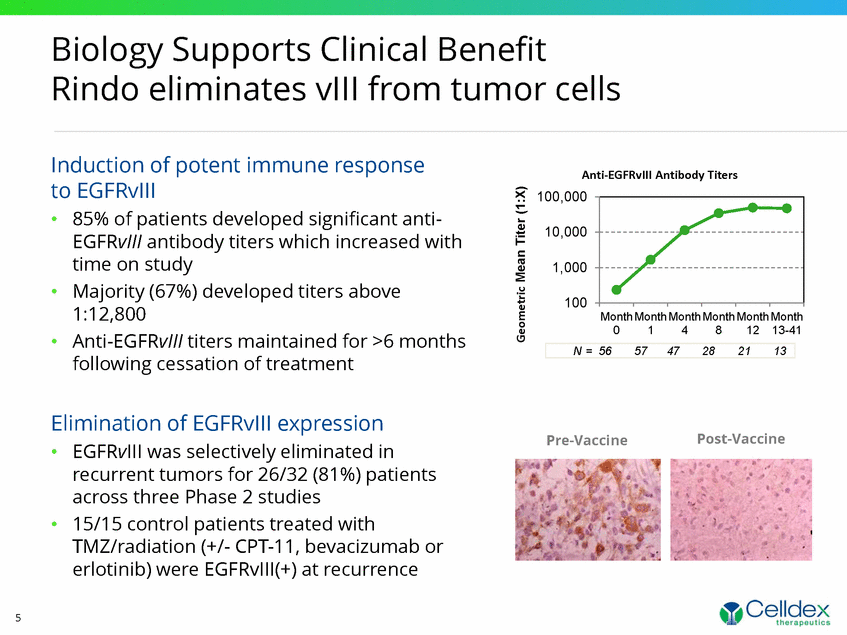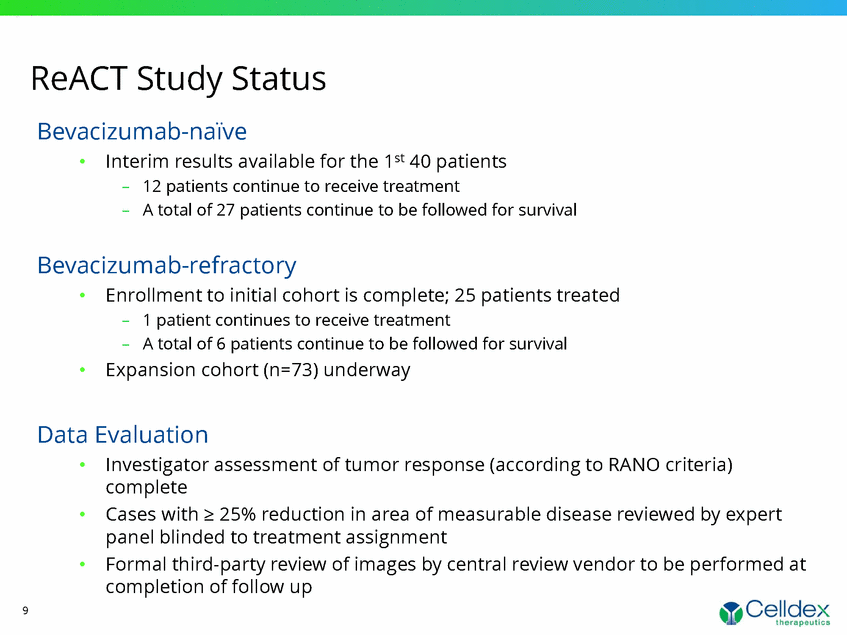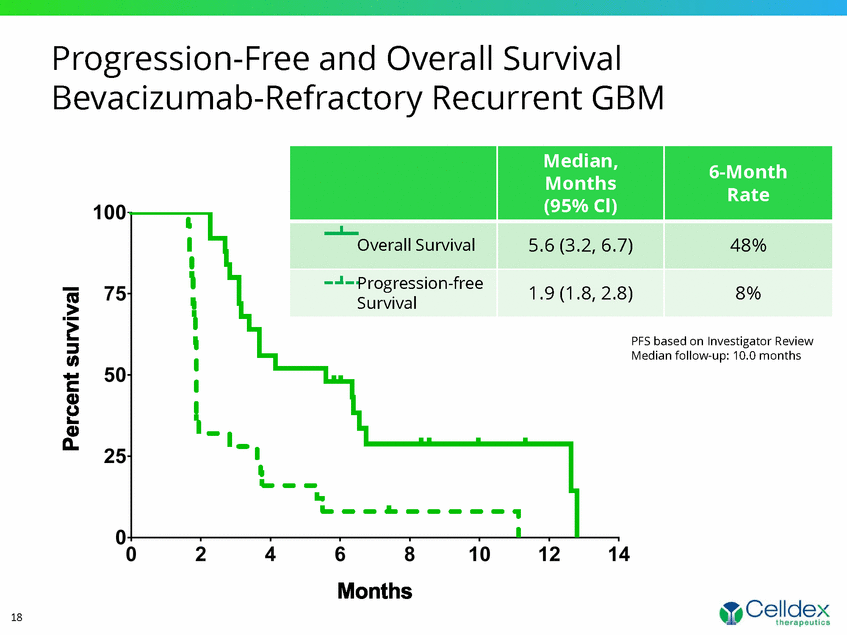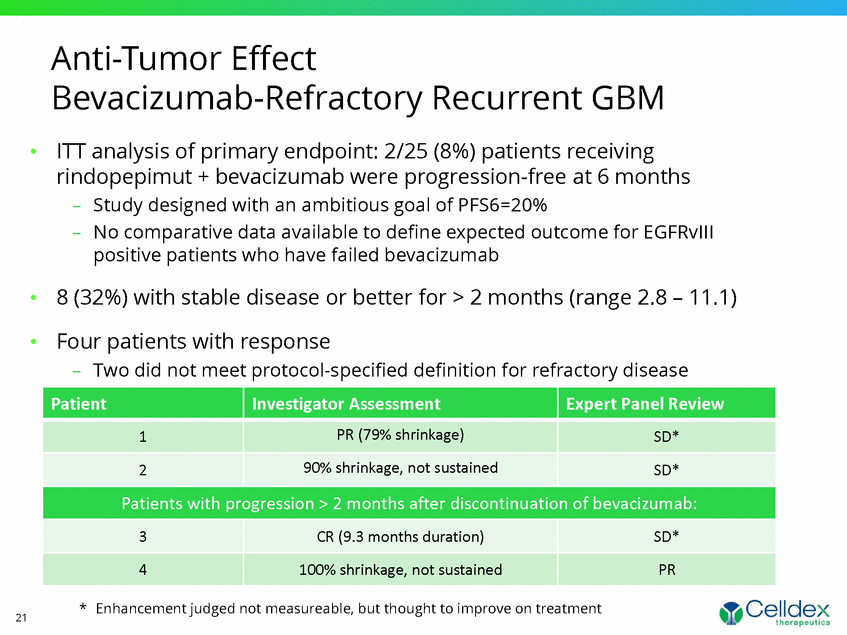Attached files
| file | filename |
|---|---|
| 8-K - 8-K - Celldex Therapeutics, Inc. | a13-24996_28k.htm |
Exhibit 99.1
|
|
Rindopepimut Society for Neuro-Oncology (SNO) 2014 Update November 25, 2013 |
|
|
Forward Looking Statement This communication contains "forward-looking" statements within the meaning of the Private Securities Litigation Reform Act of 1995. All statements other than statements of historical fact are statements that could be forward-looking statements. You can identify these forward-looking statements through our use of words such as “may,” “will,” “can,” “anticipate,” “assume,” “should,” “indicate,” “would,” “believe,” “contemplate,” “expect,” “seek,” “estimate,” “continue,” “plan,” “point to,” “project,” “predict,” “could,” “intend,” “target,” “potential” and other similar words and expressions of the future. These forward-looking statements are subject to risks and uncertainties that may cause actual future experience and results to differ materially from those discussed in these forward-looking statements. Important factors that might cause such a difference include, but are not limited to, the timing, cost and uncertainty of obtaining regulatory approvals for product candidates; our ability to develop and commercialize products before competitors that are superior to the alternatives developed by such competitors; the validity of our patents and our ability to avoid intellectual property litigation, which can be costly and divert management time and attention; and the other factors listed under “Risk Factors” in our filings with the SEC, including Forms 10-K, 10-Q and 8-K. Celldex does not undertake any obligation to release publicly any revisions to such forward-looking statement to reflect events or circumstances after the date hereof or to reflect the occurrence of unanticipated events. 2 |
|
|
Rindopepimut: A Phase 3 Immunotherapy Targeting EGFRvIII-expressing Glioblastoma • Rindopepimut is the only vaccine in development targeting EGFRvIII (v3) • EGFRvIII – Highly tumor specific, expressed only in tumors not normal tissues – Target has been validated, gaining importance as a tumor marker – Historical poor prognosis for vIII patients, historical median survival ~13-15 months, few survive two years – ~30% of GB express EGFRvIII (~4,000 EGFRvIII patients in US and ~8,800 in EU annually) • Strong proprietary patent position • Fast track U.S. granted • Orphan Drug Status in US and EU (7 yrs. & 10 yrs.) 3 |
|
|
EGFR Mutation Variant III (EGFRvIII) • Tumor-specific oncogene expressed in one-third of primary GBM, seldom expressed with IDH mutations but not in normal tissue • EGFRvIII(+) cells may induce growth in EGFRvIII(-) cells via paracrine signaling, membrane-derived microvesicles and tumor stem cells1-4 • Rindopepimut consists of EGFRvIII peptide conjugated to Keyhole Limpet Hemocyanin (KLH) – Generates a specific immune response against EGFRvIIIexpressing GBM – “Off the shelf” – Delivered as intradermal injection of 500 µg rindopepimut with 150 µg GMCSF as an adjuvant EGFRvIII Linked To Poor Long Term Survival5 1. Inda, et al. Genes Dev. 2010: 2. Al-Nedawi, et al. Nat Cell Biol. 2008 3. Wong, et al. JCO. 2008 4. Fan, et al. Cancer Cell 2013 5. Pelloski, et al. JCO. 2007 4 |
|
|
Biology Supports Clinical Benefit Rindo eliminates vIII from tumor cells Induction of potent immune response to EGFRvIII • 85% of patients developed significant anti- EGFRvIII antibody titers which increased with time on study • Majority (67%) developed titers above 1:12,800 • Anti-EGFRvIII titers maintained for >6 months following cessation of treatment Elimination of EGFRvIII expression • EGFRvIII was selectively eliminated in recurrent tumors for 26/32 (81%) patients across three Phase 2 studies • 15/15 control patients treated with TMZ/radiation (+/- CPT-11, bevacizumab or erlotinib) were EGFRvIII(+) at recurrence Anti-EGFRvIII Antibody Titers 100 1,000 10,000 100,000 Month 0 Month 1 Month 4 Month 8 Month 12 Month 13-41 N = 56 57 47 28 21 13 Geometric Mean Titer (1:X) Pre-Vaccine Post-Vaccine 5 |
|
|
Rationale for Rindopepimut Plus Bevacizumab in Recurrent GBM • Compassionate use evidence suggest that rindopepimut may induce specific immune responses and regression in multifocal and bulky tumors – Marked tumor regression with rindopepimut in combination with standard treatments – Central review of ACT III patient scans • Bevacizumab may optimize EGFRvIIIspecific immune response2-4 – VEGF may mediate immunosuppression (impairs DC maturation, alters tumor endothelium, potentially decreasing immune cell infiltration) – Bevacizumab shown to enhance immune-mediated anti-tumor effects in tumor models Bevacizumab-experienced patients are historically difficult to treat Treatment ORR (%) PFS6 (%) Median PFS (months) Median OS (months) Bev + chemo5 0 2 1.2 2.7 Bev + chemo6 0 5 2.5 4.0 Bev + irinotecan7 0 - 1.0 - Bev + carboplatin & irinotecan8 0 16 2.3 5.8 Bev + TMZ9 0 0 0.9 2.9 Bev + etoposide9 0 8 1.9 4.4 Bev + temsirolimus10 0 - 1.8 3.5 MPC-682711 4 - 0.7 3.2 Bev + dasatinib12 0 0 0.9 2.6 1. Sampson 2008 2. Johnson 2007 3. Shrimali 2010 4. Osada 2008 5. Quant 2009 6. Chamberlain 2011 7. Kreisl 2009 8. Reardon 2011 9. Reardon 2011 10. Lassen 2013 11. Grimm 2010 12. Lu-Emerson 2011 6 |
|
|
Phase II ReACT Study Design 7 |
|
|
Phase 2 ReACT Study Design cont. Eligibility • 1st or 2nd relapse of GBM • EGFRvIII+ (as per centralized IDE-approved RT-PCR assay) • Prior conventional radiation and temozolomide • No radiation within 3 months of entry • Systemic corticosteroid therapy = 4 mg of dexamethasone daily • No metastatic disease, diffuse leptomeningeal disease, gliomatosis cerebri, or infratentorial disease • No prior intracerebral agents (excluding diagnostic and imaging agents), antibody-based investigational therapy within 28 days, or non-protein based investigational therapy within 14 days of entry Objectives Exploratory study designed to estimate outcome for patients with relapsed EGFRvIII+ GBM treated with standard of care +/- rindopepimut • Primary: Progression-free survival rate at 6 months • Secondary: – Objective response rate (ORR, using RANO criteria1), overall PFS, overall survival (OS) – Safety and tolerability – EGFRvIII-specific immune response 1. Wen, et al. JCO. 2010 8 |
|
|
ReACT Study Status Bevacizumab-naïve • Interim results available for the 1st 40 patients – 12 patients continue to receive treatment – A total of 27 patients continue to be followed for survival Bevacizumab-refractory • Enrollment to initial cohort is complete; 25 patients treated – 1 patient continues to receive treatment – A total of 6 patients continue to be followed for survival • Expansion cohort (n=73) underway Data Evaluation • Investigator assessment of tumor response (according to RANO criteria) complete • Cases with = 25% reduction in area of measurable disease reviewed by expert panel blinded to treatment assignment • Formal third-party review of images by central review vendor to be performed at completion of follow up 9 |
|
|
Patient Characteristics 10 Bevacizumab Refractory (n=25) Bevacizumab Naïve Rindopepimut + Bevacizumab (n=20) Control (KLH) + Bevacizumab (n=20) Age, years (median [range]) =50 years (n [%]) 58 (39-79) 20 (80%) 60 (51-79) 20 (100%) 56 (30-75) 15 (75%) Male (n [%]) 16 (64%) 9 (45%) 11 (55%) KPS (n [%]) 100 90 80 70 1 (4%) 7 (28%) 6 (24%) 11 (44%) 0 7 (35%) 8 (40%) 5 (25%) 3 (15%) 6 (30%) 7 (35%) 4 (20%) De novo GBM (n [%]) 25 (100%) 20 (100%) 19 (95%) Time from diagnosis to first study vaccination, months (median [range]) 16.0 (8.4-58.6) 8.6 (4.5-55.3) 12.0 (5.6-33.8) Prior relapses (n [%]) 12 4 (16%) 21 (84%) 18 (90%) 2 (10%) 16 (80%) 4 (20%) Time to relapse with prior bevacizumab, months (median [range]) 4.8 (0.5-42) - - Any surgery after last relapse (n [%]) Gross-total Resection Partial resection/biopsy 4 (16%) 3 (12%) 1 (4%) 4 (20%) 3 (15%) 1 (5%) 5 (25%) 3 (15%) 2 (10%) On steroids at study entry (n [%]) 7 (28%) 11 (55%) 11 (55%) |
|
|
Group 1: Bevacizumab-Naive Recurrent GBM |
|
|
Months Overall Survival (%) 0 2 4 6 8 10 12 14 16 18 20 0 25 50 75 100 Progression-Free Survival (%) HR = 0.74 (0.34, 1.61) p = 0.47 12 Overall and Progression-Free Survival Bevacizumab-Naïve Recurrent GBM – Interim Data HR = 0.43 (0.13, 1.44) p = 0.16 Median follow-up: 6.4 months for rindopepimut 5.8 months for control Median OS, Months (95% CI) Median PFS, Months (95% CI) Rindopepimut + Bevacizumab (n=20) 12.0 (5.8, Not est.) 3.7 (1.9, 3.9) Control + Bevacizumab (n=20) 7.9 (4.1, Not est.) 2.0 (1.9, 5.6) |
|
|
First Controlled Data for EGFRvIII Supports that EGFRvIII Patients Fare Worse than the General GBM population Median OS, Months Median PFS, Months Bevacizumab only (AVF3708g, all comers) 9.3 4.2 Bevacizumab only (ReACT Control , EGFRvIII only) 7.9 2.0 13 |
|
|
14 Early Anti-EGFRvIII Response Correlates with Survival in Recurrent GBM Treated with Rindopepimut + Bevacizumab Bevacizumab-Naïve * Based on the generation of anti-EGFRvIII antibody titer = 1:12,800 by Day 57. Similar results observed at Day 29 as well as across a range of cut-off values (1:800 to 1:12,800). HR (95% CI): Not yet defined p = 0.1 Overall Survival (%) Median OS Months (95% CI) 6-Month OS (%) Highest Titers* (n=8) Not yet defined 100% All others (n=10) 10.5 (1.9, Not est.) 64% |
|
|
Tumor Shrinkage: Bevacizumab-Naïve Recurrent GBM 15 > PD PR Maximum Shrinkage of Target Lesions 15 Control + Bevacizumab Rindopepimut + Bevacizumab -100% -75% -50% -25% 0% 25% 50% 75% 100% |
|
|
16 Preliminary Analysis of Anti-Tumor Effect Bevacizumab-Naïve Recurrent GBM ** Two additional patients receiving rindopepimut+bev and one patient receiving control+bev have experienced >50% shrinkage by either investigator or expert panel review, and are pending followup for confirmation of response. Rindopepimut + Bevacizumab Control + Bevacizumab Steroids initiated or increased (1st adjustment) 1/20 (5%) 7/20 (35%) ORR (confirmed CR/PR)1,2 3/19 (16%)** 2/16 (13%)** Any response (=50% shrinkage) including those not sustained at subsequent assessment1 By Investigator review By Expert Panel review By Either review 7/19 (37%) 6/19 (32%) 9/19 (47%) 3/16 (19%) 4/16 (25%) 4/16 (25%) Stable disease or better for = 2 months 14/20 (70%) 11/20 (55%) 1. Response-evaluable patient subset with measurable disease 2. All concordant between investigator and expert panel review |
|
|
Group 2: Bevacizumab-Refractory Recurrent GBM |
|
|
Progression-Free and Overall Survival Bevacizumab-Refractory Recurrent GBM 18 PFS based on Investigator Review Median follow-up: 10.0 months Median, Months (95% Cl) 6-Month Rate Overall Survival 5.6 (3.2, 6.7) 48% Progression-free Survival 1.9 (1.8, 2.8) 8% |
|
|
Overall Survival (%) 19 Early Anti-EGFRvIII Response Correlates with Survival in Recurrent GBM Treated with Rindopepimut + Bevacizumab Bevacizumab-Refractory * Based on the generation of anti-EGFRvIII antibody titer = 1:12,800 by Day 57. Similar results observed at Day 29 as well as across a range of cut-off values (1:800 to 1:12,800). HR (95% CI): 0.33 (0.08-0.67) p = 0.009 Median OS Months (95% CI) 6-Month OS (%) Highest Titers* (n=13) 6.6 (3.7, 12.6) 69% All others (n=11) 3.2 (2.3, 4.1) 18% |
|
|
Tumor Shrinkage Bevacizumab-Refractory Recurrent GBM PD PR * * 20 Maximum Shrinkage of Target Lesions Data from Investigator Read * Previously treated with bevacizumab but did not have progression within 2 months of discontinuation. > -100% -75% -50% -25% 0% 25% 50% 75% 100% 125% 150% 175% 200% |
|
|
Anti-Tumor Effect Bevacizumab-Refractory Recurrent GBM • ITT analysis of primary endpoint: 2/25 (8%) patients receiving rindopepimut + bevacizumab were progression-free at 6 months – Study designed with an ambitious goal of PFS6=20% – No comparative data available to define expected outcome for EGFRvIII positive patients who have failed bevacizumab • 8 (32%) with stable disease or better for > 2 months (range 2.8 – 11.1) • Four patients with response – Two did not meet protocol-specified definition for refractory disease Patient Investigator Assessment Expert Panel Review 1 PR (79% shrinkage) SD* 2 90% shrinkage, not sustained SD* Patients with progression > 2 months after discontinuation of bevacizumab: 3 CR (9.3 months duration) SD* 4 100% shrinkage, not sustained PR 21 * Enhancement judged not measureable, but thought to improve on treatment |
|
|
1. One ongoing Partial Response (-79% shrinkage in measurable disease) by Investigator assessment; deemed Stable Disease due to lack of clearly measurable disease by expert panel • Patient continues treatment at 8.3 months • Prior treatments: partial resection, radiation and temozolomide with progression at 6.1 months post-diagnosis, bevacizumab with 2nd relapse at 3.5 months 2. One patient with -90% shrinkage in measurable disease by Investigator assessment; deemed Stable Disease due to lack of clearly measurable disease by expert panel • Response at 2 months was followed by progression at 4 months • Prior treatments: partial resection, radiation and temozolomide with progression at 3.7 months post-diagnosis, radiation, bevacizumab with 2nd relapse 4.6 months later 22 Anti-Tumor Effect Bevacizumab-Refractory Recurrent GBM |
|
|
63 yr, female with PD after XRT/TMZ and 7 cycles of adjuvant TMZ; then 2nd PD after 3.5 months on BEV monotherapy Pre-Rindopepimut Ongoing response after 5 cycles of Rindopepimut + BEV Patient continues to be progression free, currently at 8+ months of treatment with rindopepimut + BEV Tumor Response in Bevacizumab-Refractory Recurrent GBM 23 |
|
|
Anti-Tumor Effect Bevacizumab-Refractory Recurrent GBM cont. 3. One Complete Response (9.3 months duration) by Investigator assessment; deemed Stable Disease due to lack of clearly measurable disease by expert panel • Patient experienced progression-free survival of 11 months • Prior treatments: Gross-total resection, radiation and temozolomide. Adjuvant bevacizumab was switched to temozolomide due to toxicity after 3 months. 1st relapse occurred 5.4 months later 4. One with -100% shrinkage in measurable disease by Investigator assessment; assessed as a robust Partial Response (4 months duration) by expert review panel • Patient experienced progression-free survival of 5.5 months • Prior treatments: Gross-total resection, radiation and temozolomide, with adjuvant bevacizumab and temozolomide. Bevacizumab was discontinued due to toxicity after 8 months and relapse occurred three years later 24 Responses seen in both patients who had previously received bevacizumab, but did not meet strict definition of refractory per ReACT protocol |
|
|
Safety |
|
|
Safety: Bevacizumab-Refractory and Bevacizumab-Naïve Recurrent GBM • Rindopepimut plus bevacizumab (dosing for up to 13 months) has been well-tolerated – No unexpected toxicity associated with concomitant bevacizumab administration – No treatment-related toxicity resulting in discontinuation of study treatment • Treatment-related toxicity consistent with previous studies – Grade 1-2 injection site reactions (primarily erythema and pruritus) in the majority of patients – One grade 2 hypersensitivity reaction (dyspnea, throat tightness, chest pain) – Cerebral edema limited to one Grade 1 event 26 |
|
|
ReACT Conclusions • Rindopepimut combined with bevacizumab was very well tolerated • Remarkable frequency and level of anti-EGFRvIII immune responses were generated despite prior chemotherapy and growing tumor • Encouraging tumor response and survival data – 48% OS rate at 6 months in refractory patients – Trend toward more frequent tumor shrinkage and improved survival in early/interim examination of naïve patients – The subjectivity of response evaluation in GBM continues to be a complex issue • Early development of anti-EGFRvIII titer may be predictive of improved outcome – Improved survival associated with rapid generation of humoral response • Refractory population expansion cohort (n=73) underway, accrual to naïve arm ongoing • Results support the potential for efficacy in newly diagnosed patients – ACT IV trial data pending 27 |
|
|
Additional Updates |
|
|
Rindopepimut: Long-Term Follow-up from Phase 2 Trials in de novo GBM Overall Survival (%) • Three Phase 2 Studies: ACTIVATE (n=18), ACT II (n = 22), ACT III (n=65) . Newly diagnosed, resected, EGFRvIII-expressing GBM • Significant anti-EGFRvIII immunity in 85% of ACT III patients (67% > 1:12,800) • EGFRvIII eliminated from 86% of recurrent tumors • Very little toxicity • International Phase 3 study ongoing ** Patients treated at M.D. Anderson contemporaneously to ACTIVATE, matched for major eligibility requirements, including EGFRvIII+ GBM, GTR and no PD through CRT. Median, Years (95% CI) 2-year rate 3-year rate 4-year rate 5-year rate Phase II Rindopepimut Studies, Pooled (n=105) 2.1 (1.8, 2.4) 51% 30% 18%* 14%* Matched historical control (n=17)** 1.3 (0.9, 1.7) 6% 6% 0% 0% HR (95% CI): 0.31 (0.19, 0.53) p < 0.0001 *ACT III OS rate: 4-years = 18% 5-years = 14% 29 |
|
|
ACT IV: Phase 3 Study in Newly-Diagnosed EGFRvIII-positive Glioblastoma • Randomized (1:1), double-blind, placebo controlled study in up to 450 patients with newly diagnosed, surgically resected, EGFRvIII-positive glioblastoma (including 374 patients with minimal residual disease) (adaptive design); approx. 200 international sites in 20+ countries • Rindopepimut/GM-CSF with standard of care (SoC) maintenance temozolomide vs blinded control (KLH) with SoC • Study objectives - Overall survival (primary), PFS (RANO criteria), safety, immune response, QoL, elimination of EGFRvIII expression • Includes sample size re-estimation and interim analyses where the trial may terminate early for futility or success 30 |
|
|
ACT IV Status Update • In this adaptive design study, total accrual is dependent on the following variables: – Overall enrollment rate – Patients with minimal residual disease – Rate of events (deaths) • 351 patients have been randomized to date • Due to event rate and patient mix, enrollment will exceed 450 patients and is expected to continue to mid-year 2014 • First interim analysis anticipated late 2014/early 2015 • Further update on year-end call in February 31 |
|
|
Q&A |
































